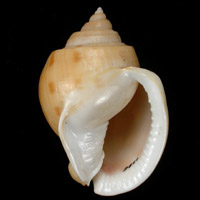|
< Previous family introduction |
|
|||||
 |
Family
Cassidae
Helmet Shells
|
|||||
|
The family Cassidae contains medium to large size shells which occur in tropical and temperate seas. There are about 60 species, most of which occur from the intertidal down to about 100 m in depth. The species which occur in NSW belong to three distributional groups. Four species which occur in the tropical Indo-West Pacific extend into NSW, rarely reaching as far south as Sydney. One species has a southern Australian distribution, known in NSW from only a few specimens from near the NSW-Victoria border. The remaining species are found in eastern and southern Australia, extending to New Zealand, the Kermadec Islands and South Africa in several cases. Members of this family are renowned for great shell variability, which is particularly evident in two NSW species, Semicassis pyrum and S. labiatum. This has lead to a number of variants being described as species, subspecies and forms, some of which still require investigation to determine their exact relationships. Most helmet shells live buried in the sand by day, coming out at night to feed on echinoderms, especially sea urchins, which they can locate by smell from at least 30 centimetre away. They immobilise the urchin, crawl onto it with the thick skin of the foot providing protection from the spines, and make a hole in the urchin shell by an acidic secretion and by rasping with the radula, and suck out the soft parts. Family References
Identification Notes In the Cassidae the columellar callus extends onto the ventral surface and is referred to as the columellar shield. The margin of the columellar shield, which is the edge away from the aperture, may adhere to the ventral surface of the whorl or be free standing, and may be straight, indented, or convex. The shield itself may be smooth or sculptured. In addition to those illustrated, the following three Indo-West Pacific species occur infrequently in northern NSW:
Phalium areola Phalium bandatum |